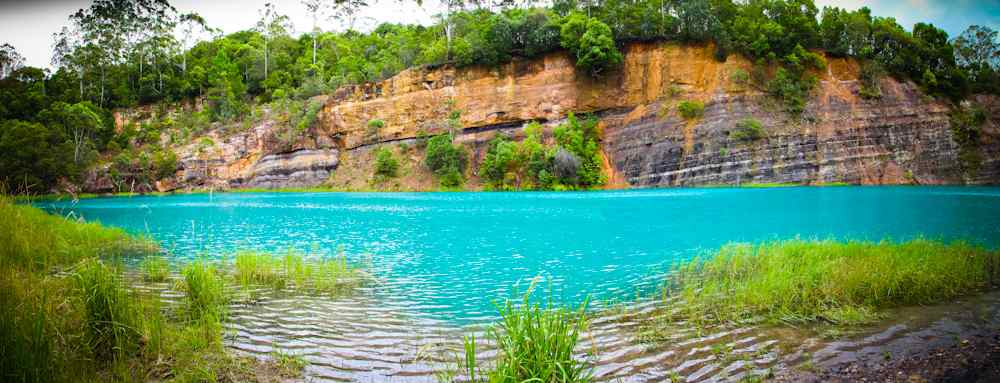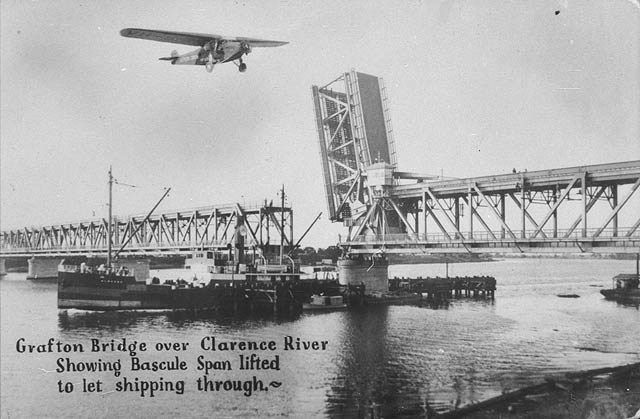|
Clarence Moreton Basin
The Clarence Moreton Basin is a Mesozoic sedimentary basin on the easternmost part of the Australian continent. It is located in the far north east of the state of New South Wales around Lismore and Grafton and in the south east corner of Queensland. It is the part of the Great Artesian Basin that extends to the east coast in Australia's central eastern lowlands. Description It formed by oblique extension of the underlying Paleozoic New England Orogen basement. It consists of continental deposits, starting with a small amount of Triassic coal beds, and then mostly Jurassic and Cretaceous sedimentary rocks. The basin covers . The basin was named when the Clarence Basin (named after the Clarence River) and Moreton Basin in Queensland were proved to be one structure. Oil is likely to be present in the basin. Stratigraphy The oldest rocks in the Clarence Moreton Basin of New South Wales are the Chillingham Volcanics. These are from some time in the Triassic period, ... [...More Info...] [...Related Items...] OR: [Wikipedia] [Google] [Baidu] |
Bexhill, New South Wales
Bexhill is a small village in New South Wales, Australia. As of 2006, the town had a population of 472 people. It is located about from Byron Bay and about from Lismore and is in the City of Lismore. It is on the Murwillumbah railway line and on Bangalow Road. Attractions Bexhill is well known for its pleasant open air cathedral which is managed by volunteers of the Uniting Church. The "cathedral" has attractive native gardens and overlooks a large length of valley and hills along Coopers Creek. It is well used for wedding services and special events. The village also contains an old brick pit which is officially closed for recreational purposes due to metal contaminated water naturally leached from the surrounding rocks but the attractive colour of the lake in the pit and Bexhills hot summer weather mean that many people swim there despite the danger. Geography The village is located on the end of a ridge of basalt hills. The village itself is located on sedimentary roc ... [...More Info...] [...Related Items...] OR: [Wikipedia] [Google] [Baidu] |
Grafton, New South Wales
Grafton ( Bundjalung-Yugambeh: Gumbin Gir) is a city in the Northern Rivers region of the Australian state of New South Wales. It is located on the Clarence River (New South Wales), Clarence River, approximately by road north-northeast of the state capital Sydney. The closest major cities, Brisbane and the Gold Coast, Queensland, Gold Coast, are located across the border in South-East Queensland. At the Census in Australia#2021, 2021 census, Grafton had a population of 19,255. The city is the largest settlement and, with Maclean, New South Wales, Maclean, the shared administrative centre of the Clarence Valley Council local government area, which is home to over 50,000 people in all. History Before European settlement, the Clarence River marked the border between the Bundjalung people, Bundjalung [...More Info...] [...Related Items...] OR: [Wikipedia] [Google] [Baidu] |
Nymboida Coal Measures
Nymboida is a village in New South Wales, Australia. It may also refer to other subjects in the area: *Nymboida National Park *Nymboida River The Nymboida River, a perennial stream of the Clarence River catchment, is located in the Northern Rivers region of New South Wales, Australia. Course and features The Nymboida River rises in the northern foothills of the Barren Mountain, on t ... * Nymboida Power Station * Nymboida Shire; a now defunct local government area. {{Geodis ... [...More Info...] [...Related Items...] OR: [Wikipedia] [Google] [Baidu] |
Chillingham, New South Wales
Chillingham is a small village approximately 14 km northwest of Murwillumbah in the Tweed Valley, New South Wales, Australia. The Rous River Rous River, a perennial river of the Tweed River catchment, is located in the Northern Rivers region of New South Wales, Australia. Course and features Rous River rises below Mount Hobwee on the southern slopes of the McPherson Range, near Nu ..., a tributary of the Tweed River, flows through the town. Chillingham Post Office opened on 28 May 1923. A Telegraph Office had been open since 1913, known for some months as ''Bean Tree''. References External linksTweed Tourism Inc - visitor information for the Tweed region (including Chillingham) Suburbs of Tweed Heads, New South Wales {{NorthernRivers-geo-stub ... [...More Info...] [...Related Items...] OR: [Wikipedia] [Google] [Baidu] |
Outcrop
An outcrop or rocky outcrop is a visible exposure of bedrock or ancient superficial deposits on the surface of the Earth. Features Outcrops do not cover the majority of the Earth's land surface because in most places the bedrock or superficial deposits are covered by soil and vegetation and cannot be seen or examined closely. However, in places where the overlying cover is removed through erosion or tectonic uplift, the rock may be exposed, or ''crop out''. Such exposure will happen most frequently in areas where erosion is rapid and exceeds the weathering rate such as on steep hillsides, mountain ridges and tops, river banks, and tectonically active areas. In Finland, glacial erosion during the last glacial maximum (ca. 11000 BC), followed by scouring by sea waves, followed by isostatic uplift has produced many smooth coastal and littoral outcrops. Bedrock and superficial deposits may also be exposed at the Earth's surface due to human excavations such as quarrying and build ... [...More Info...] [...Related Items...] OR: [Wikipedia] [Google] [Baidu] |
Chillingham Volcanics
Chillingham can refer to: * Chillingham (game), a computer game designed for the visually impaired * Chillingham, New South Wales, a village in New South Wales, Australia * Chillingham, Northumberland, a village in Northumberland in the north of England * Chillingham Castle, an ancient castle in Northumberland, England, near Chillingham * Chillingham cattle Chillingham cattle, also known as Chillingham wild cattle, are a breed of cattle that live in a large enclosed park at Chillingham Castle, Northumberland, England. In summer 2022 the cattle numbers 138 animals with approximately equal numbers o ..., a herd of rare cattle which have lived for centuries in the grounds of Chillingham Castle, in Northumberland, England * Chillingham Road Metro station, a metro station in Newcastle upon Tyne, England * , a minesweeper of the British Royal Navy {{disambig, geo ... [...More Info...] [...Related Items...] OR: [Wikipedia] [Google] [Baidu] |
Kangaroo Creek Sandstone 4
Kangaroos are four marsupials from the family Macropodidae (macropods, meaning "large foot"). In common use the term is used to describe the largest species from this family, the red kangaroo, as well as the antilopine kangaroo, eastern grey kangaroo, and western grey kangaroo. Kangaroos are indigenous to Australia and New Guinea. The Australian government estimates that 42.8 million kangaroos lived within the commercial harvest areas of Australia in 2019, down from 53.2 million in 2013. As with the terms "wallaroo" and "wallaby", "kangaroo" refers to a paraphyletic grouping of species. All three terms refer to members of the same taxonomic family, Macropodidae, and are distinguished according to size. The largest species in the family are called "kangaroos" and the smallest are generally called "wallabies". The term "wallaroos" refers to species of an intermediate size. There are also the tree-kangaroos, another type of macropod, which inhabit the tropical ra ... [...More Info...] [...Related Items...] OR: [Wikipedia] [Google] [Baidu] |
Clarence River (New South Wales)
The Clarence River ( Bundjalung: ''Boorimbah'', Yaygir: ''Ngunitiji'') is a river situated in the Northern Rivers district of New South Wales, Australia. The river rises on the eastern slopes of the Great Dividing Range, in the Border Ranges west of Bonalbo, near Rivertree at the junction of Koreelah Creek and Maryland River, on the watershed that marks the border between New South Wales and Queensland. The river flows generally south, south east and north east, joined by twenty-four tributaries including the Tooloom Creek and the Mann, Nymboida, Cataract, Orara, Coldstream, Timbarra, and Esk rivers. The river reaches its mouth at its confluence with the Coral Sea in the South Pacific Ocean, between Iluka and Yamba; descending over the course of its length. On its journey it passes through the towns of Tabulam and Copmanhurst, the city of Grafton, and the towns of Ulmarra, and Maclean. The river features many large river islands, including Woodford, Chatsw ... [...More Info...] [...Related Items...] OR: [Wikipedia] [Google] [Baidu] |
Government Of New South Wales
The Government of New South Wales, also known as the NSW Government, is the States and territories of Australia, Australian state democratic administrative authority of New South Wales. It is currently held by a coalition of the Liberal Party of Australia (New South Wales Division), Liberal Party and the National Party of Australia – NSW, National Party. The Government of New South Wales, a parliamentary system, parliamentary constitutional monarchy, was formed in 1856 as prescribed in its New South Wales#Constitution, Constitution, as amended from time to time. Since the Federation of Australia, Federation of Australia in 1901, New South Wales has been a state of the Australian Government, Commonwealth of Australia, and the Constitution of Australia regulates its relationship with the Commonwealth. Under the Constitution of Australia, Australian Constitution, New South Wales, as with all states, ceded legislative and judicial supremacy to the Commonwealth, but retained powers ... [...More Info...] [...Related Items...] OR: [Wikipedia] [Google] [Baidu] |
Geological Society Of Australia
The Geological Society of Australia (GSA) was established as a non-profit organisation in 1952 to promote, advance and support earth sciences in Australia. The founding Chairperson was Edwin Sherbon Hills. William Rowan Browne was a founder of the society and was president 1955–56. at Australian Dictionary of Biography Publications *''Australian Journal of Earth Sciences
The ''Australian Journal of Earth Sciences'' is a peer-reviewed scientific journal that is published eight times per year by Taylor & Francis on behalf of the Geological Society of Australia. The journal bro ...
[...More Info...] [...Related Items...] OR: [Wikipedia] [Google] [Baidu] |
Cretaceous
The Cretaceous ( ) is a geological period that lasted from about 145 to 66 million years ago (Mya). It is the third and final period of the Mesozoic Era, as well as the longest. At around 79 million years, it is the longest geological period of the entire Phanerozoic. The name is derived from the Latin ''creta'', "chalk", which is abundant in the latter half of the period. It is usually abbreviated K, for its German translation ''Kreide''. The Cretaceous was a period with a relatively warm climate, resulting in high eustatic sea levels that created numerous shallow inland seas. These oceans and seas were populated with now- extinct marine reptiles, ammonites, and rudists, while dinosaurs continued to dominate on land. The world was ice free, and forests extended to the poles. During this time, new groups of mammals and birds appeared. During the Early Cretaceous, flowering plants appeared and began to rapidly diversify, becoming the dominant group of plants across the Ear ... [...More Info...] [...Related Items...] OR: [Wikipedia] [Google] [Baidu] |
Jurassic
The Jurassic ( ) is a geologic period and stratigraphic system that spanned from the end of the Triassic Period million years ago (Mya) to the beginning of the Cretaceous Period, approximately Mya. The Jurassic constitutes the middle period of the Mesozoic Era and is named after the Jura Mountains, where limestone strata from the period were first identified. The start of the Jurassic was marked by the major Triassic–Jurassic extinction event, associated with the eruption of the Central Atlantic Magmatic Province. The beginning of the Toarcian Stage started around 183 million years ago and is marked by an extinction event associated with widespread oceanic anoxia, ocean acidification, and elevated temperatures likely caused by the eruption of the Karoo-Ferrar large igneous provinces. The end of the Jurassic, however, has no clear boundary with the Cretaceous and is the only boundary between geological periods to remain formally undefined. By the beginning of the Jurassi ... [...More Info...] [...Related Items...] OR: [Wikipedia] [Google] [Baidu] |





